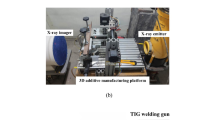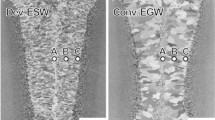Abstract
The electroslag welding process involves high heat inputs and high deposition rates. In this process, the weld region is surrounded by the base metal and/or devices; therefore, it is difficult to observe the phenomenon and understand the mechanism of weld formation. In this study, we directly observe the molten region formed during the process and construct a numerical model to discuss the phenomena especially the construction of the molten region, the flow field of the molten region, and the metal transfer. A device for direct observation was constructed, and the molten region was observed. The molten slag flows from the wire tip to the molten metal interface, and the direction of flow is changed to the side at the interface. The molten metal flows from the center to the side region at the interface of the slag and metal. The penetration depth is governed by the behavior of the molten metal. In addition, droplet transfer from the wire is observed, and this transfer occurs in the spray or rotating mode. The simulation results indicate a tendency similar to that deduced via direct observations. Thus, the mechanism of penetration can be elucidated more clearly using these tools.











Similar content being viewed by others
References
Kitani Y, Ikeda R, Ono M, Ikeuchi K (2009) Improvement of weld metal toughness in high heat input electro-slag welding of low carbon steel. Weld World 53:R57–R63
Iyama J, Matsumoto Y, Ishii T, Shimokawa H, Nikaido M, Yamada S (2019) Fracture strength of electroslag welding joint with high-performance steel. J Constr Steel Res 153:495–508
Kenyon N, Redfern GA, Richardson RR (1975) Electroslag welding of high nickel alloys. Weld Res Supplement 54:235s–239s
Bennett CR, Swanson JA, Linzell DG (2009) Fatigue resistance of HPS-485 W (70 W) welded butt-splice connections using narrow gap improved electroslag welding. J Bridg Eng 14:529–536
Deng D, Kiyoshima S (2012) Numerical simulation of welding temperature field, residual stress and deformation by electro slag welding. Comput Mater Sci 62:23–34
Potapov NN, Rymkevich AI, Roshchin MB (2012) Special features of metallurgical processes in the electroslag welding of structural steels using fluxes with reduced basicity. Weld Int 26:476–480
Debroy T, Szekely J, Eagar TW (1980) Heat generation patterns and temperature profiles in electroslag welding. Metall Trans B 11B:593–605
Ando K, Wada H (1970) Studies on the electroslag welding (report 1) – penetration mechanism of base metal and influence of polarity effect. J Japan Weld Soc 39:669–676 (in Japanese)
Ando K, Nakata S, Wada H (1971) Studies on the electroslag welding (report 2) – influence of welding conditions on the penetration of base metal. J Japan Weld Soc 40:1016–1025 (in Japanese)
Ando K, Nakata S, Wada H (1971) Studies on the electroslag welding (report 3) – influence of electrical conductance of flux on the penetration of base metal. J Japan Weld Soc 40:1104–1110 (in Japanese)
Ando K, Nakata S, Wada H (1973) Studies on the electroslag welding (report 4) – melting phenomena of wire in electroslag welding. J Japan Weld Soc 42:106–113 (in Japanese)
Solari M, Biloni H (1977) The effect of wire feed speed on structure in electroslag welding of low carbon steel. Weld Res Supplement 56:274s–280s
Dilawari AH, Szekely J, Eagar TW (1978) Electromagnetically and thermally driven flow phenomena in electroslag welding. Metall Trans B 9B:371–381
Dilawari AH, Eager TW, Szekely J (1978) An analysis of heat and fluid flow phenomena in electroslag welding. Weld Res Supplement 57:24s–30s
Mendez PF, Goett G, Guest SD (2015) High-speed video of metal transfer in submerged arc welding. Weld J 94:326s–333s
Reisgen U, Schaefer J, Willms K (2016) Analysis of the submerged arc in comparison between a pulsed and non-pulsed process. Weld World 60:703–711
Hirt CW, Nichols BD (1981) Volume of fluid (VOF) method for the dynamics of free boundaries. J Comput Phys 39:201–225
Brackbill JU, Kothe DB, Zamach C (1992) A continuum method for modeling surface tension. J Comput Phys 100:335–354
Rao ZH, Hu J, Liao SM, Tsai HL (2010) Modeling of the transport phenomena in GMAW using argon–helium mixtures. Part I – the arc. Int J Heat Mass Transf 53:5707–5721
Ushio M, Wu CS (1997) Mathematical modeling of three-dimensional heat and fluid flow in a moving gas metal arc weld pool. Metall Mater Trans B 28B:509–516
Kharicha A, Ludwig A, Wu M (2014) On melting of electrode during electro-slag remelting. ISIJ Int 54:1621–1628
Wang X, Li Y (2015) A comprehensive 3D mathematical model of the electroslag remelting process. Metall Mater Trans B 46B:1837–1849
Wang F, Wang Q, Lou Y, Chen R, Song Z, Li B (2016) Investigation of heat transfer and magnetohydrodynamic flow in electroslag remelting furnace using vibrating electrode. JOM 68:410–420
Author information
Authors and Affiliations
Corresponding author
Additional information
Publisher’s note
Springer Nature remains neutral with regard to jurisdictional claims in published maps and institutional affiliations.
Recommended by Study Group 212 - The Physics of Welding
Rights and permissions
About this article
Cite this article
Ogino, Y., Fukumoto, S., Asai, S. et al. Direct observation and numerical simulation of molten metal and molten slag behavior in electroslag welding process. Weld World 64, 1897–1904 (2020). https://doi.org/10.1007/s40194-020-00969-1
Received:
Accepted:
Published:
Issue Date:
DOI: https://doi.org/10.1007/s40194-020-00969-1




